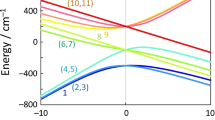Abstract
The electron paramagnetic resonance (EPR) spectra of the trigonal prismatic complexes Tc(abt)3, Tc(bdt)3, Re(abt)3 and Re(bdt)3 (abt, O-aminobenzenethiol; bdt, benzene-1,2-dithiol) in dilute frozen solution are interpreted in terms of an axially symmetric spin Hamiltonian, with g values close to two, principal hyperfine couplings of |A Tc| ~ 5–12 × 10−4 cm−1, nuclear quadrupole couplings of |P Tc| ~ 0.3–0.35 × 10−4 cm−1 and the unusual values 5 × 10−4 cm−1 ~ |A Re zz | < |P Re| ~ |A Re xx | ~ |A Re yy | ~ 25 × 10−4 cm−1. Similar magnitudes of the parameters have been obtained by simulation of the previously published spectra of Re(pda)3, Re(tdt)3 and Re(pdt)3 (pda, O-phenylenediamine; tdt, toluene-3,4-dithiol; pdt, cis-1,2-diphenylethene-1,2-dithiol) by other authors. The unexpectedly large value of P relative to A is a common feature of all the Re tris-dithiolato and related trigonal prismatic complexes studied by EPR and is attributed to the high degree of delocalization of the unpaired electron onto the ligands and the distortion of the electron charge cloud. These factors are less evident in the complexes Tc(abt)3 and Tc(bdt)3. Intermolecular dipolar interactions, narrowed by weak exchange, are responsible for some of the spectral features observed in the solid state and concentrated (≫1 mM) frozen solutions, although there is no evidence for specific solute–solute interactions.




Similar content being viewed by others
References
Progress in Inorganic Chemistry, vol. 52, Dithiolene Chemistry: Synthesis, Properties, and Applications, ed. by K.D. Karlin, E.I. Steifel (Wiley, New York, 2004)
F.J. Hine, A.J. Taylor, C.D. Garner, Coord. Chem. Rev. 254, 1570–1579 (2010)
S.C. Drew, J.P. Hill, I. Lane, G.R. Hanson, R.W. Gable, C.G. Young, Inorg. Chem. 46, 2373–2387 (2007)
S.C. Drew, C.G. Young, G.R. Hanson, Inorg. Chem. 46, 2388–2397 (2007)
S.C. Drew, G.R. Hanson, Inorg. Chem. 48, 2224–2232 (2009)
M. Kawashima, M. Koyama, T. Fujinaga, J. Inorg. Nucl. Chem. 38, 801–805 (1976)
R. Kirmse, J. Stach, H. Spies, Inorg. Chim. Acta 45, L251–L253 (1980)
E.I. Steifel, H.B. Gray, J. Am. Chem. Soc. 87, 4012–4013 (1965)
E.I. Steifel, R. Eisenberg, R.C. Rosenberg, H.B. Gray, J. Am. Chem. Soc. 88, 2956–2966 (1966)
A.H. Al-Mowali, A.L. Porte, J. Chem. Soc. Dalton Trans., 250–252 (1975)
J. Baldas, J.F. Boas, J. Bonnyman, J.R. Pilbrow, G.A. Williams, J. Am. Chem. Soc. 107, 1891–1896 (1985)
A.A. Danopoulos, A.C.C. Wong, G. Wilkinson, M. Hursthouse, B. Hussain, J. Chem. Soc. Dalton Trans., 315–331 (1990)
L.V. Borisova, O.D. Prasolova, G.A. Evtikova, I.N. Marov, Zh. Neorg, Khim. 35, 944–950 (1990)
U. Abram, R. Kirmse, Radiochim. Acta 63, 139–143 (1993)
A.H. Al-Mowali, A.L. Porte, J. Chem. Soc. Dalton Trans., 50–55 (1975)
G.N. Schrauzer, V.P. Mayweg, J. Am. Chem. Soc. 88, 3235–3242 (1966)
S.C. Drew, J. Baldas, J.F. Boas, Inorg. Chem. 49, 6799–6801 (2010)
S. Sproules, F.L. Benedito, E. Bill, T. Weyhermuller, S. DeBeer George, K. Wieghardt, Inorg. Chem. 48, 10926–10941 (2009)
J. Baldas, J.F. Boas, J. Bonnyman, M.F. Mackay, G.A. Williams, Aust. J. Chem. 35, 2413–2422 (1982)
J.K. Gardner, N. Pariyadath, J.L. Corbin, E.I. Steifel, Inorg. Chem. 17, 897–904 (1978)
J.E. Wertz, J.W. Orton, P. Auzins, Faraday Discuss. 31, 140–150 (1961)
G.R. Hanson, K.E. Gates, C.J. Noble, M. Griffin, A. Mitchell, S.J. Benson, J. Inorg. Biochem. 98, 903–916 (2004)
P. Pyykkö, Mol. Phys. 99, 1617–1629 (2001)
J. Baldas, J.F. Boas, G.A. Williams, Appl. Magn. Reson. 11, 499–508 (1996)
J.R. Morton, K.F. Preston, J. Magn. Reson. 30, 577–582 (1978)
Author information
Authors and Affiliations
Corresponding authors
Electronic supplementary material
Below is the link to the electronic supplementary material.
Figure S1. Phase memory times (T M) of Re(abt)3 (10 mM) measured as a function of magnetic field (blue circles). The red squares show the amplitude of the exponential fit to the two-pulse echo decay that was used to obtain T M. The phase memory time varies across the field range in which a detectable echo was generated and is shorter near the centre field compared with the shoulder features. Experimental parameters: microwave frequency, 9.70 GHz; temperature, 3 K; pulse sequence, t π/2–τ–t π–τ–echo; pulse lengths, t π/2 = t π/2 = 56 ns, τ incremented from 216 to 4280 ns in 16 ns steps; shots per loop, 50; averages, 10. Error bars depict errors reported from the mono-exponential fitting routine of Xepr.
Figure S2. Simulations showing the influence of varying the magnitude of P on the CW-EPR spectrum. The g and A matrices are the same as those used to simulate Re(bdt)3 (Table 3 and Fig. 2, main text), while P varies from (a) 0 × 10−4cm−1, (b) 6 × 10−4cm−1, (c) 12 × 10−4cm−1 and (d) 24 × 10−4cm−1. Grey lines show a 5× expansion of the ordinate in each instance.
Rights and permissions
About this article
Cite this article
Drew, S.C., Baldas, J. & Boas, J.F. The Unusual Magnetic Resonance Properties of Trigonal Prismatic Tc and Re Complexes. Appl Magn Reson 40, 427–440 (2011). https://doi.org/10.1007/s00723-011-0226-4
Received:
Published:
Issue Date:
DOI: https://doi.org/10.1007/s00723-011-0226-4




